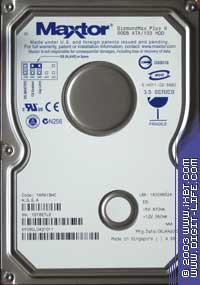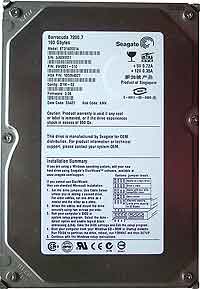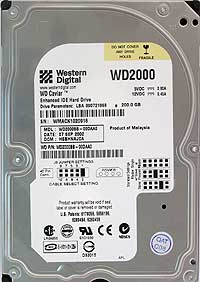 |
||
|
||
| ||
Apparently, hard drives with a 2MB buffer are gradually passing to the low-end niche. Size, buffer, spindle speed, data rates are all growing up... Probably in a couple of years hard drives with such buffer will be considered a thing of the past, like drives rotating at 5400 rpm today (I mean 3.5" drives used in usual desktop PCs). But while the drive makers keep on releasing new models we will keep on examining them. So, today we have the following drives to test (in alphabetic order): Hitachi HDS722580VLAT20, Maxtor 6Y080L0, Samsung SP1604N, Seagate ST3160021A, WD 2000BB. If you remember, Maxtor and WD drives were reviewed quite recently, while the Hitachi performs for the first time. The necessity to review it and see how it compare s to the rest was what made us work on this roundup. Hitachi Deskstar 7K250 HDS722580VLAT20  This Hitachi drive belongs to the Deskstar 7K250 series, which is the first ATA series released (though not developed from nothing) by Hitachi Global Storage since it got IBM's HDD division (the previous Hitachi Deskstar 180GXP was just a remarked IBM Deskstar 180GXP series earlier developed by IBM). This series includes 7 PATA drives, 40 to 250GB, with 2 and 8MB buffers, and 4 SATA drives, 80 to 250GB, with an 8MB buffer. However, the new label doesn't look less mysterious: Hitachi keeps on using a long 15-symbol code. Here's how it officially decodes:
PATA drives of this line with the 2MB buffer have the capacity of 40, 80, 120 or 160GB.
Maxtor DiamondMax Plus 9 6Y080L0  This drive was tested several times already. Just note that in the DiamondMax Plus 9 line the drives with the 2MB buffer can measure 60, 80, 120 and 160GB.
Samsung SpinPoint SP1604N  The drive is from the SpinPoint P80 line. Its record density is 80 GB per platter. It was launched quite a short time ago, but it was benchmarked several times already. The drives with the 2MB buffer can be of 60, 80, 120 and 160GB.
Seagate Barracuda 7200.7 ST3160021A  Barracuda 7200.7 line. The drives of this line with the 2MB buffer can be 40, 80, 120 and 160GB. Record density's 80GB per platter.
Western Digital WD2000BB  This drives reminds me a brontosaurus, a giant animal with a very small brain. This is the most sizable drive today with a 2MB buffer. Western Digital is the only drive maker that produces 200GB drives with a 2MB buffer, while the other companies have it limited at 160GB. Moreover, they have recently brought out the drive marked WD2500BB, i.e. its size is 250GB with the buffer being only 2MB! The WD2000BB holds on to one of the leading positions in our roundups though it's not a newcomer on the market. Drives' specs:
TestsTestbed.
The test suite is standard:
It would be more correct to compare drives of the same size, while we have two groups at least - the 80GB drives (one platter) and 160GB (two platters). Plus there is the WD2000BB with three platters. I hope next time I will get the roundup to the "common denominator" - 160GB. Besides, we have recently found out that the Maxtor DiamondMax Plus 9 drives make a single checkup at writing. Unfortunately, when the 6Y080L0 was tested before that fact was revealed, that is why the scores can be understated. Nevertheless, I didn't remove it from the roundup, - this will be one more reason for future update. Ziff-Davis WinBench 99 / HDTach 2.61Among the drives with 80 GB per platter the leading position belongs
to the Samsung, while the Seagate Barracuda 7200.7 falls behind. The
Hitachi is in the main group. The WD2000BB has a lower record density but
the scores are not that bad.  Hitachi Deskstar 7K250 HDS722580VLAT20  Maxtor 6Y080L0  Samsung SP1604N  Seagate ST3160023A  Western Digital WD 2000BB
HDTach doesn't look trustworthy anymore, especially for the drives
with a 8MB buffer. It's the last time when we use this benchmark. The Hitachi traditionally looks pretty good: IBM drives (which precede
this line) always had a low access time. The Ziff-Davis Disk WinMarks much depend on controller's drivers,
that is why it would be correct to compare drives tested on the same controller
and with the same drivers. It's difficult to single out a leader in case of
the FAT32. The Maxtor 6Y080L0 scores the best results in the High-End Disk
WinMark, but loses in the Business, and it's vice versa for the WD2000BB.
The Hitachi looks pretty good, but the benchmark is already 4 years old, and
I'm not sure if it reflects real operation with real applications as file
volumes grew up. But there's no replacement. In case of the NTFS the leader is Samsung, and the outsider is the Hitachi. Intel IOMeterThis test reveals real performance, but it's synthetic, i.e. performance
is estimated in a certain model instead of real modern applications. What
should we do? Let's think about it, maybe we will make our own benchmark.
The Hitachi looks better in case of heavy loads. The access time looks good
but it still loses to the WD and Samsung at light loads. On the contrary,
the Samsung doesn't like big loads, though it's excusable for a desktop model.
The picture's the same. In the Database model the Hitachi falls behind. What's the reason?
Is it because of extra 13% of requests for recording? It looks like that. While the Hitachi demonstrates excellent random reading, its random writing looks pretty bad. There's only the Seagate Barracuda 7200.7 that follows it. But writing is not the weakest point of this drive. If you add some requests for reading, the Hitachi's performance will drop even more. If the number of reading operations decreases in linear fashion, the number of writing operations grows up much slower. Is it because the buffer provides less space for the lazy write? It's interesting to look at its scores with the 8MB buffer. Now come the serial modes. The drive gets requests for writing or
reading of data blocks the size of which is gradually growing up. The queue
depth is fixed at 4 (very light). Well, the Hitachi writes data slower as well. NoiseIn this respect I don't feel any difference between these drives and those with the serial interface. The Samsung SP1614C is the quietest, with the WD2500JD and Hitachi Deskstar 7K250 following it. The Seagate Barracuda 7200.7 produces a bit more noise, and it's also noisier than its predecessor. The Maxtor is the loudest among the 7200 RPM drives. ConclusionSo, the Samsung and WD drives look best of all. The Hitachi
could get more credits if it were not its strange recording. I'll try to find
and test such drive with an 8MB buffer. The Seagate Barracuda 7200.7
falls behind the pack. The Maxtor is not that bad. Write a comment below. No registration needed!
|
| ||||||||||||||||||||||||||||||||||||||||||||||||||||||||||||||||||||||||||||||||||||||||||||||||||||||||||||||||||||||
Platform · Video · Multimedia · Mobile · Other || About us & Privacy policy · Twitter · Facebook
Copyright © Byrds Research & Publishing, Ltd., 1997–2011. All rights reserved.